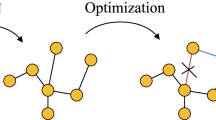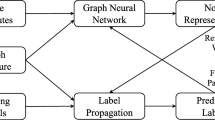Abstract
Graph is a widely existed data structure in many real world scenarios, such as social networks, citation networks and knowledge graphs. Recently, Graph Convolutional Network (GCN) has been proposed as a powerful method for graph-based semi-supervised learning, which has the similar operation and structure as Convolutional Neural Networks (CNNs). However, like many CNNs, it is often necessary to go through a lot of laborious experiments to determine the appropriate network structure and parameter settings. Fully exploiting and utilizing the prior knowledge that nearby nodes have the same labels in graph-based neural network is still a challenge. In this paper, we propose a model which utilizes the prior knowledge on graph to enhance GCN. To be specific, we decompose the objective function of semi-supervised learning on graphs into a supervised term and an unsupervised term. For the unsupervised term, we present the concept of local inconsistency and devise a loss term to describe the property in graphs. The supervised term captures the information from the labeled data while the proposed unsupervised term captures the relationships among both labeled data and unlabeled data. Combining supervised term and unsupervised term, our proposed model includes more intrinsic properties of graph-structured data and improves the GCN model with no increase in time complexity. Experiments on three node classification benchmarks show that our proposed model is superior to GCN and seven existing graph-based semi-supervised learning methods.





Similar content being viewed by others
Explore related subjects
Discover the latest articles, news and stories from top researchers in related subjects.References
Atwood J, Towsley DF (2016) Diffusion-convolutional neural networks. In: Advances in neural information processing systems, pp 1993–2001
Belkin M, Niyogi P, Sindhwani V, Bartlett P (2006) Manifold regularization: a geometric framework for learning from examples. J Mach Learn Res 7(1):2399–2434
Blum A, Mitchell TM (1998) Combining labeled and unlabeled data with co-training. In: Proceedings of the 11th annual conference on computational learning theory, pp 92–100
Bronstein MM, Bruna J, Lecun Y, Szlam A, Vandergheynst P (2017) Geometric deep learning: going beyond euclidean data. IEEE Signal Process Mag 34(4):18–42
Bruna J, Zaremba W, Szlam A, Lecun Y (2014) Spectral networks and locally connected networks on graphs. In: Proceedings of the 2th international conference on learning representations
Chapelle OZA, Scholkopf B (2006) Semi-supervised learning. MIT Press, Cambridge
Chen J, Ma T, Xiao C (2018) Fastgcn: Fast learning with graph convolutional networks via importance sampling. In: Proceedings of the 6th international conference on learning representations
Defferrard M, Bresson X, Vandergheynst P (2016) Convolutional neural networks on graphs with fast localized spectral filtering. pp 3844–3852
Duvenaud DK, Maclaurin D, Aguileraiparraguirre J, Gomezbombarelli R, Hirzel TD, Aspuruguzik A, Adams RP (2015) Convolutional networks on graphs for learning molecular fingerprints. In: Advances in neural information processing systems, pp 2224–2232
Fout A, Byrd J, Shariat B, Benhur A (2017) Protein interface prediction using graph convolutional networks. In: Advances in neural information processing systems, pp 6530–6539
Fujino A, Ueda N, Saito K (2005) A hybrid generative/discriminative approach to semi-supervised classifier design. In: Proceedings of the 19th AAAI conference on artificial intelligence, pp 764–769
Glorot X, Bengio Y (2010) Understanding the difficulty of training deep feedforward neural networks. In: Proceedings of the 13th international conference on artificial intelligence and statistics, pp 249–256
Goyal P, Ferrara E (2018) Graph embedding techniques, applications, and performance: a survey. Knowl Based Syst 151:78–94
Grover A, Leskovec J (2016) Node2vec: scalable feature learning for networks. In: Proceedings of the 22nd ACM SIGKDD international conference on knowledge discovery and data mining, pp 855–864
Hamilton WL, Ying Z, Leskovec J (2017) Inductive representation learning on large graphs. In: Advances in neural information processing systems, pp 1024–1034
Joachims T (1999) Transductive inference for text classification using support vector machines. In: Proceedings of the 16th international conference on machine learning, pp 200–209
Kim Y (2014) Convolutional neural networks for sentence classification. In: Proceedings of the conference on empirical methods in natural language processing, pp 1746–1751
Kingma D, Ba J (2015) Adam: a method for stochastic optimization. In: Proceedings of the 3th international conference on learning representations
Kipf TN, Welling M (2017) Semi-supervised classification with graph convolutional networks. In: Proceedings of the 5th international conference on learning representations, pp 1–14
Krizhevsky A, Sutskever I, Hinton GE (2012) Imagenet classification with deep convolutional neural networks. In: Advances in neural information processing systems, pp 1097–1105
Kullback S, Leibler RA (1951) On information and sufficiency. Ann Math Stat 22(1):79–86
Lecun Y, Bottou L, Bengio Y, Haffner P (1998) Gradient-based learning applied to document recognition. Proc IEEE 86:2278–2324
Li Y, Tarlow D, Brockschmidt M, Zemel RS (2016) Gated graph sequence neural networks. In: Proceedings of the 5th international conference on learning representations
Li Y, Yu R, Shahabi C, Liu Y (2018) Diffusion convolutional recurrent neural network: Data-driven traffic forecasting. In: Proceedings of the 27th international joint conference on artificial intelligence
Lin J (1991) Divergence measures based on the shannon entropy. IEEE Trans Inf Theory 37(1):145–151
Lu Q, Getoor L (2003) Link-based classification. In: Proceedings of the 20th international conference on machine learning, pp 496–503
Mallat S (1999) A wavelet tour of signal processing, 2nd edn. Elsevier, San Diego
Mcpherson M, Smithlovin L, Cook JM (2001) Birds of a feather: Homophily in social networks. Rev Soc 27(1):415–444
Mikolov T, Chen K, Corrado G, Dean J (2013) Efficient estimation of word representations in vector space. In: Proceedings of the neural information processing systems conference, pp 3111–3119
Monti F, Boscaini D, Masci J, Rodola E, Svoboda J, Bronstein MM (2017) Geometric deep learning on graphs and manifolds using mixture model cnns. pp 5425–5434
Niepert M, Ahmed MO, Kutzkov K (2016) Learning convolutional neural networks for graphs. In: Proceedings of the 20th international conference on machine learning, pp 2014–2023
Nigam K, Mccallum A, Thrun S, Mitchell TM (2000) Text classification from labeled and unlabeled documents using em. Mach Learn 39(2):103–134
Perozzi B, Al-Rfou R, Skiena S (2014) DeepWalk: Online learning of social representations. In: Proceedings of the 20th ACM SIGKDD international conference on knowledge discovery and data mining, pp 701–710
Sainath TN, Vinyals O, Senior A, Sak H (2015) Convolutional, long short-term memory, fully connected deep neural networks. In: 2015 IEEE international conference on acoustics, speech and signal processing (ICASSP), IEEE, pp 4580–4584
Scarselli F, Gori M, Tsoi AC, Hagenbuchner M, Monfardini G (2009) The graph neural network model. IEEE Trans Neural Netw 20(1):61–80
Shuman DI, Narang SK, Frossard P, Ortega A, Vandergheynst P (2013) The emerging field of signal processing on graphs: extending high-dimensional data analysis to networks and other irregular domains. IEEE Signal Process Mag 30(3):83–98
Velickovic P, Cucurull G, Casanova A, Romero A, Lio P, Bengio Y (2018) Graph attention networks. In: Proceedings of the 6th international conference on learning representations
Weston J, Ratle F, Mobahi H, Collobert R (2008) Deep learning via semi-supervised embedding. In: Proceedings of the 25th international conference on machine learning, pp 1168–1175
Yang Z, Cohen W, Salakhutdinov R (2016) Revisiting semi-supervised learning with graph embeddings. In: Proceedings of the 33th international conference on machine learning, pp 40–48
Yu B, Yin H, Zhu Z (2018) Spatio-temporal graph convolutional networks: a deep learning framework for traffic forecasting. pp 3634–3640
Zachary WW (1977) An information flow model for conflict and fission in small groups. J Anthropol Res 33(4):452–473
Zhou D, Bousquet O, Lal TN, Weston J, Olkopf BS (2004) Learning with local and global consistency. Adv Neural Inf Process Syst 16:321–328
Zhu X (2005) Zhu X (2005) Semi-supervised learning literature survey. Tech. rep., University of Wisconsin-Madison Department of Computer Sciences
Zhu X, Ghahramani Z, Lafferty JD (2003) Semi-supervised learning using Gaussian fields and harmonic functions. In: Proceedings of the 20th international conference on machine learning, pp 912–919
Acknowledgements
This work was funded by the National Natural Science Foundation of China under Grant No. U1636220 and 61532006, and Beijing Municipal Natural Science Foundation under Grant No. 4172063.
Author information
Authors and Affiliations
Corresponding author
Ethics declarations
Conflict of Interest
The authors declare that they have no conflict of interest.
Additional information
Publisher's Note
Springer Nature remains neutral with regard to jurisdictional claims in published maps and institutional affiliations.
Rights and permissions
About this article
Cite this article
Yu, S., Yang, X. & Zhang, W. PKGCN: prior knowledge enhanced graph convolutional network for graph-based semi-supervised learning. Int. J. Mach. Learn. & Cyber. 10, 3115–3127 (2019). https://doi.org/10.1007/s13042-019-01003-7
Received:
Accepted:
Published:
Issue Date:
DOI: https://doi.org/10.1007/s13042-019-01003-7




